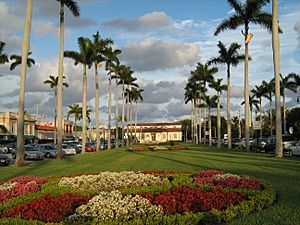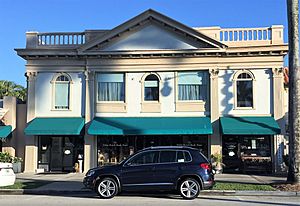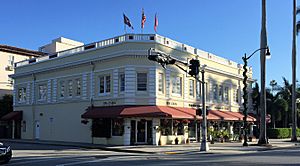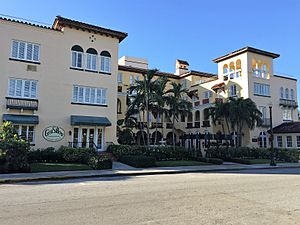Royal Poinciana Way Historic District facts for kids
Quick facts for kids |
|
|
Royal Poinciana Way Historic District
|
|
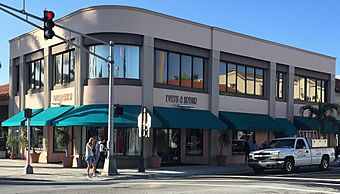
Royal Poinciana Way Historic District at 100 North County Road
|
|
| Location | 207-283 Royal Poinciana Way, 95-118 North County Road, and 184-280 Sunset Avenue, Palm Beach, Florida |
|---|---|
| Built | 1915-1954 |
| Architect | Several people |
| Architectural style | Art Moderne, Mediterranean Revival, Mid-Century Modern, Mission Revival, Neoclassical Revival |
| NRHP reference No. | 15000588 |
| Added to NRHP | September 17, 2015 |
The Royal Poinciana Way Historic District is a special area in Palm Beach, Florida. It's a place where old shops and homes stand, showing how the town used to be. This district includes buildings along Royal Poinciana Way, North County Road, and Sunset Avenue. There are 36 buildings here, and 26 of them are considered important to the district's history. The Royal Poinciana Way Historic District was added to the National Register of Historic Places (NRHP) on September 17, 2015. A post office in the district has been on the NRHP since 1983. The town of Palm Beach also sees the post office, Bradley House Hotel, and Biltmore Apartments as important landmarks.
This area, once called Main Street, was the main spot for shopping and town activities in early Palm Beach. This was because a bridge for walking and trains was built here in 1901. It was the only way to get to Henry Flagler's famous hotels, The Breakers and the Royal Poinciana Hotel, until 1911. The historic buildings you see today in the district were built between 1915 and 1954. Many architects helped design them, including well-known names like Martin L. Hampton and Gustav Maass.
Contents
History of Royal Poinciana Way
Early Days and Flagler's Influence
Businessman Henry Flagler built the Royal Poinciana Hotel in 1894 and The Breakers in 1896. Both hotels were just south of where the Royal Poinciana Way Historic District is now. Flagler's Florida East Coast Railway reached West Palm Beach in 1894. The next year, a train bridge over Lake Worth was finished. This made it easier for tourists to reach his hotels in Palm Beach.
The first train bridge was south of the Royal Poinciana Hotel. But in 1901, a new bridge was built north of the hotel. This new bridge allowed both trains and people to cross. Since it was the only direct way into Palm Beach until 1911, the area around it became the town's main street. Many early shops and important town activities happened in the Royal Poinciana Way Historic District. Also, some of the first big homes in Palm Beach were built nearby.
Growth and the Florida Land Boom
During World War I, fewer new homes were built in Palm Beach. However, more tourists started visiting because they chose to travel within the country. To serve these visitors, several buildings went up along Main Street between 1915 and 1919. These are the oldest buildings in the Royal Poinciana Way Historic District today.
One of the first buildings, now part of Via Testa at 221A Royal Poinciana Way, was probably used as a jail. Another important building from the 1910s was the Campbell Building, built in 1918. It's at 277-283 Royal Poinciana Way. The first floor of this building had Palm Beach’s post office, a grocery store, and other shops. The second floor had a dance floor, a casino, and a restaurant.
The Royal Poinciana Way area stayed important in the 1920s. Many more buildings were constructed because of the Florida land boom. In 1924, a newspaper called The Palm Beach Post said Royal Poinciana Way was "the heart of Palm Beach." It mentioned the post office, bank, and many different shops all adding to the street's busy feel.
Changes in the 1930s and Beyond
During the Great Depression, the richest people in Palm Beach were not affected much. But many others stopped their winter vacations. This caused business to slow down on Royal Poinciana Way. Later in the 1930s, the street truly became a "gateway" to Palm Beach.
In 1937, Main Street was renamed Royal Poinciana Way. That same year, the street was made wider, and a grassy area (median) was added in the middle. This median had rows of royal palm trees and shrubs. On July 1, 1938, the Flagler Memorial Bridge was finished. This new bridge replaced the old train and pedestrian bridge from 1901. It allowed cars to drive directly onto Royal Poinciana Way. Before this, only the Royal Park Bridge had allowed cars since 1911.
After World War II, tourism and building new places picked up again. In the early 1950s, many old small houses were torn down. In their place, new apartment buildings and condos were built. Some buildings also had second floors added. The newest historic building in the Royal Poinciana Way Historic District is at 244 Sunset Avenue. It was built from 1952 to 1954.
On September 17, 2015, the Royal Poinciana Way Historic District was officially listed on the National Register of Historic Places.
Historic Buildings and Architecture
The Royal Poinciana Way Historic District has 36 buildings. Twenty-six of these are considered "contributing" because they are old and important to the district's history. Ten others are "noncontributing" because they were built after 1954 or changed too much. Here are some of the important buildings:
North County Road Buildings
- United States Post Office at 95 North County Road. This building was designed in the Mediterranean Revival style and finished in 1937. It has been on the National Register of Historic Places since 1983.
- The Exchange Building at 100 North County Road. This building was first designed in 1924 in the Mediterranean Revival style. But in 1941, it was greatly changed to the Art Moderne style.
- Building at 101 North County Road. This building is also in the Art Moderne style and was built in 1936.
- Building at 105 North County Road. A Mediterranean Revival building from 1925. It used to have a gift shop, real estate office, and stockbroker's office.
- Building at 106 North County Road. This is a one-story building built in 1941.
- Building at 108-110 North County Road. A two-story commercial building from 1941.
- Buildings at 112, 114, and 118 North County Road. These are all one-story commercial buildings, also built in 1941.
Royal Poinciana Way Buildings
- Building at 207 Royal Poinciana Way. A Mediterranean Revival-style building from 1927. It has mostly been home to restaurants.
- Building at 211 Royal Poinciana Way. Part of a larger building (209-215 Royal Poinciana Way) built in 1921. This building originally held an 800-seat movie theater called the Garden Theater. On its opening day in 1921, it showed a silent film called The Affairs of Anatol.
- Testa's Restaurant, at 221 Royal Poinciana Way. A two-story building built in 1947. This building, along with Via Testa, was torn down in October 2017.
- Via Testa, two buildings at 221-A and 221-B Royal Poinciana Way. The building at 221-A was built around 1915 and likely served as the town jail. The building at 221-B was built in 1925. These buildings were also torn down in October 2017.
- Building at 233-235 Royal Poinciana Way. A two-story building from 1945 with shops on the first floor and apartments above.
- Building at 249 Royal Poinciana Way. A one-story commercial building built in 1949.
- Building at 251 Royal Poinciana Way. This one-story commercial building was built around 1923.
- Building at 253 Royal Poinciana Way. A two-story commercial building from 1921.
- Campbell Building at 277-283 Royal Poinciana Way. Named after S. Ross Campbell, this building was finished around 1918. It originally housed Palm Beach’s post office, a grocery store, and other shops. The second floor had a dance floor, casino, and restaurant.
Sunset Avenue Buildings
- The Biltmore Apartments, also known as Mizner Court, at 184 Sunset Avenue. This three-story Mediterranean Revival building was designed in 1924. It has stores on the first floor and apartments on the upper floors.
- Buildings at 214 and 214A Sunset Avenue. These buildings were once known as the Clinton Hotel and Testa’s Hotel. The building at 214 Sunset Avenue was a two-story Mission Revival style building from 1920. The building at 214A was an addition from 1932. Both were torn down in October 2017.
- Building at 244 Sunset Avenue. This two-story apartment building was built from 1952 to 1954. It is the newest contributing building in the district.
- Buildings at 262 and 262A Sunset Avenue. The building at 262 Sunset Avenue is a two-story American Foursquare building from 1920. A garage, built in 1925, is also considered a historic part of the property.
- Building at 280 Sunset Avenue. This four-story Mediterranean Revival building was built in 1924. It was originally called the Rosa May Apartments and later the Bradley House Hotel. It was restored and reopened as the White Elephant Palm Beach hotel in 2020.



